Steaming: the unsung hero of low-histamine cooking!
I discovered this game-changer during my health journey. Steaming keeps veggies crisp and nutrient-packed. My go-to? A simple steamer basket.
I toss in SIGHI-approved veggies and let the magic happen. Sometimes, I'll add a twist with fresh herbs or a lemon squeeze.
It's like hitting the jackpot – tasty, healthy, and histamine-friendly. Who knew eating well could be this easy?
Got any steaming hacks to share? Let's swap tips!
My Steamy Kitchen Mishap
Picture this: Me, excited about my new steamer, ready to impress my date. I loaded it with veggies, set the timer, and… forgot about it.
Cue smoke alarms and a kitchen full of mushy vegetables. Talk about a steamy disaster!
But you know what? It taught me the importance of timing in steaming. Now, I'm a pro at perfectly steamed asparagus and broccoli.
Sometimes, kitchen fails lead to the best cooking lessons!
Key Takeaways
- Steaming retains essential nutrients and minimizes histamine levels in vegetables, making it a safe cooking method for low-histamine diets.
- Use fresh, seasonal ingredients to enhance flavor and retain freshness during steaming.
- Adjust steaming times to achieve the desired texture for various vegetables, ensuring they remain tender yet crisp.
- Combine steaming with gentle cooking methods, like poaching or blanching, to further reduce histamine levels in meals.
- Experiment with flavor enhancers like lemon zest or herbs to elevate steamed dishes without adding histamine triggers.
Understanding Low-Histamine Cooking
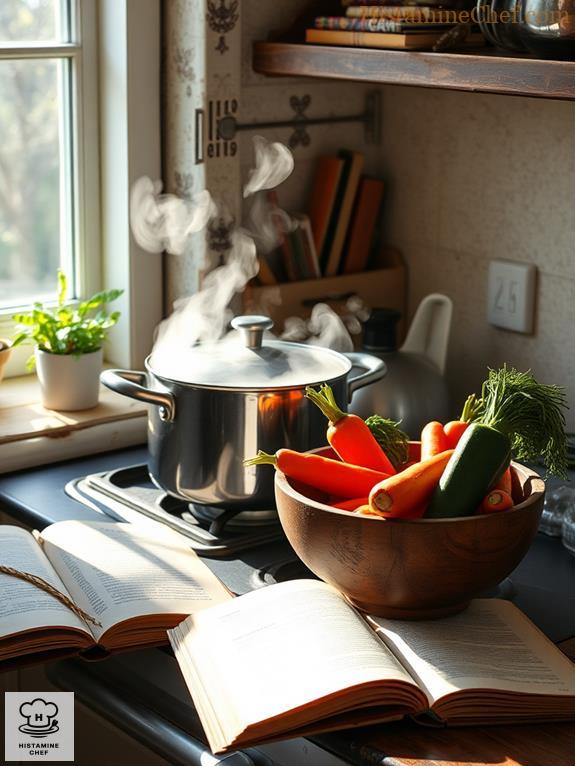
When it comes to low-histamine cooking, understanding the basics is essential for anyone looking to manage their histamine levels effectively.
I've learned that ingredient selection is key! Stick to those SIGHI-approved foods—think fresh veggies and fruits like apples and blueberries.
Meal planning becomes a breeze when you embrace cooking methods like steaming, which preserves flavor while keeping histamine at bay.
Gentle cooking methods like poaching are also excellent options for those following a low-histamine diet, as they help maintain the integrity of the food while minimizing histamine production.
Don't forget about food storage! Fresh is always best, so keep those ingredients in safe, cool spots.
As for cooking equipment, a simple steamer can work wonders.
And hey, meal prepping can save you time and help you stay on track.
Benefits of Steaming for Histamine

When it comes to cooking with low-histamine foods, steaming is one of my favorite techniques!
Not only does it help retain those essential nutrients—think vibrant veggies bursting with flavor—but it also minimizes histamine formation, which is a win-win for our tummies.
Plus, who doesn't love the idea of keeping their meals tasty without all the extra fuss?
Enhanced Nutrient Retention
Steaming vegetables is an effective method to enhance nutrient retention, especially for those following a low-histamine diet.
Have you ever noticed how vibrant steamed broccoli looks? That's because steaming boosts nutrient bioavailability! By keeping steaming temperatures low, we minimize nutrient loss, preserving those vitamins and minerals that our bodies crave.
I love how steaming makes veggies tender yet still crisp—perfect for salads or sides! You won't believe how much flavor you can capture while avoiding high-histamine foods from the SIGHI list.
So, next time you're prepping dinner, keep in mind: steam it, don't boil it! Your taste buds and body will thank you.
And that's why I write this blog, Histamine Chef. I'm here to help you navigate this flavorful journey!
Minimizing Histamine Formation
One of the key benefits of steaming is its ability to minimize histamine formation in foods. When I steam my veggies, I'm not just cooking; I'm actively reducing potential histamine triggers!
Think about it: certain foods, especially when improperly stored, can become histamine factories. Steaming helps keep those histamine levels down, making my meals friendlier for my body.
Plus, I love the vibrant colors that pop when I steam broccoli or carrots! It's like a mini celebration on my plate.
So, next time you're tempted to boil or fry, consider steaming instead. You'll not only enjoy fresher flavors but also a safer meal that supports your health.
Why do I share this? At Histamine Chef, I want you to thrive!
Flavor Preservation Techniques
Preserving the natural flavors of my vegetables is a top priority, and steaming does just that. When I steam my veggies, I notice a delightful flavor infusion that makes each bite sing. It's like giving my greens a VIP treatment!
Instead of drowning them in heavy sauces, I explore seasoning alternatives that keep things fresh and exciting. Think lemon zest or a sprinkle of fresh herbs—who knew simplicity could taste so good?
Plus, I love knowing I'm keeping histamine levels low, especially when I ditch the restricted foods on the SIGHI list.
Low-Heat Fish Poaching Techniques
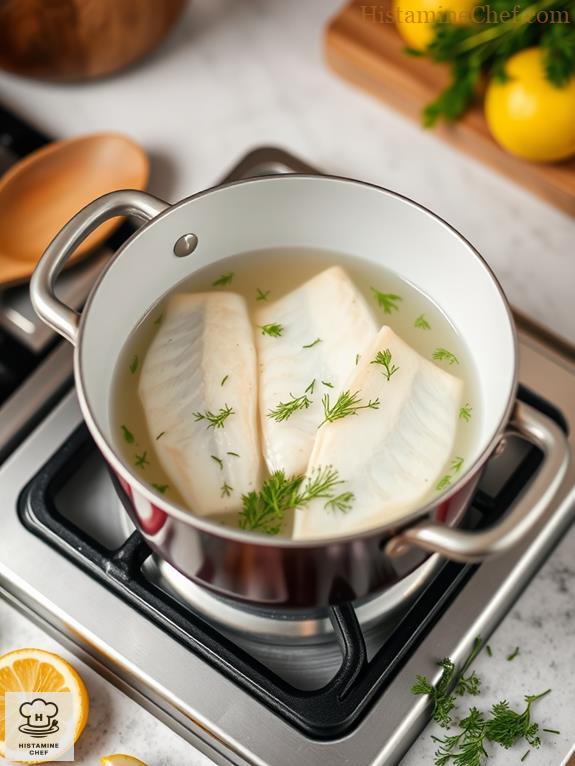
Poaching fish at low heat is a gentle method that preserves the delicate flavors and textures of fresh seafood while ensuring it's suitable for a low-histamine diet.
Smart cooking techniques like poaching can help reduce histamine content in your meals. This method is particularly effective for those with histamine intolerance, as it minimizes the formation of histamine during cooking.
When you're selecting fish, go for fresh options like cod or sole—these are low in histamine!
For poaching tips, keep your water just below simmering. You'll want to control the temperature to avoid overcooking, which can ruin the texture.
Experiment with seasoning options like fresh herbs and a sprinkle of salt for flavor enhancement.
Consider ingredient pairings with allowed vegetables, such as zucchini or carrots.
Serving suggestions? Try a light citrus drizzle (just not lemon if you're sensitive) for a revitalizing finish. Trust me, your taste buds will thank you!
Choosing Low-Histamine Ingredients
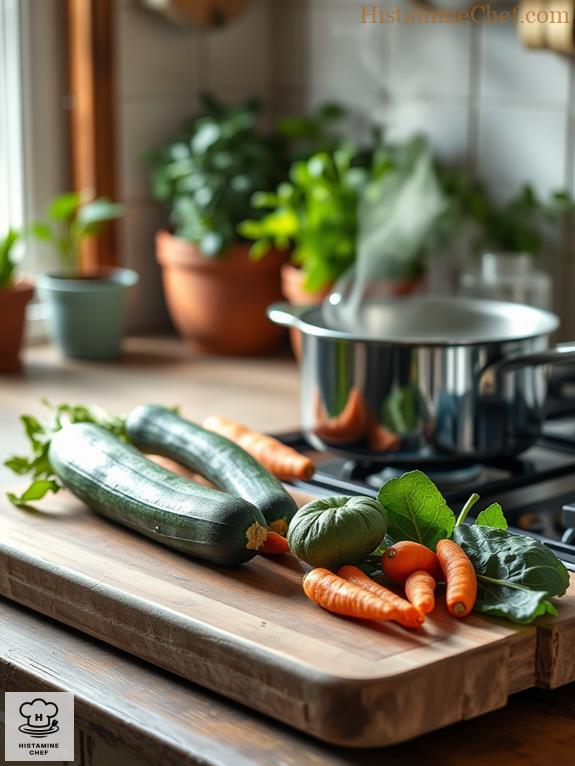
When it comes to crafting a low-histamine meal, choosing the right ingredients is vital for maintaining a balanced diet. I love exploring seasonal produce, as the freshness really makes a difference!
Try pairing colorful veggies like carrots and zucchini for delightful textural contrasts.
Reading food labels is critical when selecting low-histamine ingredients, as some products may contain hidden sources of histamine. Learning to decipher ingredient lists can help you make informed choices and avoid potential triggers.
Speaking of freshness, always store your ingredients wisely. Did you know that proper food storage can extend their life?
For meal planning, consider safe substitutions—like swapping regular pasta for quinoa.
And let's not forget flavor pairings! Fresh herbs can elevate a dish without the histamine hassle.
Remember the SIGHI list when selecting your ingredients.
Cooking can be a fun adventure, and with a bit of creativity, you'll discover delicious low-histamine delights! Happy cooking!
Combining Steaming With Other Methods
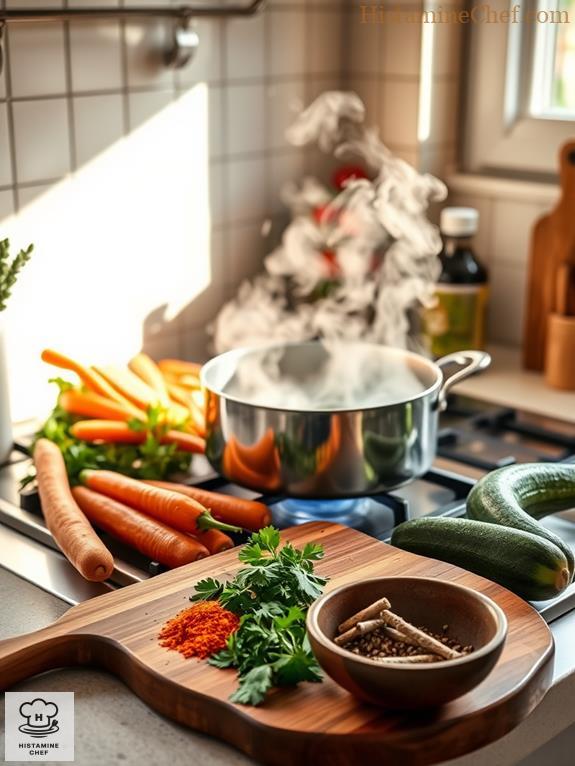
When I think about combining steaming with other cooking methods, I get really excited about the possibilities!
Blanching and boiling are also excellent low-histamine cooking methods that can be combined with steaming for ideal results. These techniques help reduce histamine levels in foods while preserving nutrients.
Picture sautéing your veggies right after steaming them, giving them that perfect tender-crisp texture, or even mixing steaming with baking for a delightful twist on traditional dishes.
Have you ever tried roasting your steamed veggies? Trust me, it's a game changer!
Steaming and Sautéing Benefits
Combining steaming with sautéing opens up a world of culinary possibilities, particularly for those following a low-histamine diet.
Imagine the vibrant colors of fresh veggies, like carrots and zucchini, dancing together in your pan! By using steaming techniques to soften the vegetables first, I find they absorb flavors better when I sauté them. It's like giving them a warm hug before their flavor party begins!
And let's not forget about the health benefits—steaming locks in nutrients while sautéing adds that irresistible aroma.
When you choose low-histamine veggies, like bell peppers and asparagus from the SIGHI list, your meals can be both delicious and safe.
Steaming With Baking Techniques
While I often think of steaming as a standalone cooking method, it can also enhance baking techniques in delightful ways.
Imagine combining steaming methods with your favorite baking alternatives, like moistening cake batter while it bakes. This keeps your treats tender and soft—no one wants a dry muffin, right?
I've experimented with adding a splash of water to my baking pan, creating a steam bath that transforms my spelt muffins into fluffy wonders. It's like giving them a spa day!
And let's not forget about veggies! Steaming zucchini before adding it to a bread recipe keeps it low-histamine and adds a delicious twist.
So, why not get creative? Your taste buds will thank you!
Happy cooking!
Combining Steaming and Roasting
Steaming and roasting together create a culinary harmony that elevates the flavors and textures of your dishes.
I love how these two cooking methods complement each other, enhancing meal prep and offering delightful dish variations.
Here are some tips to get you started:
- Explore ingredient combinations like carrots and sweet potatoes for their nutrient preservation.
- Experiment with roasting techniques to create a crispy exterior while keeping the inside tender.
- Use temperature control during steaming to guarantee perfect texture balance.
The steaming benefits, like flavor enhancement, are undeniable!
Picture biting into roasted veggies that are soft yet slightly caramelized, all while knowing you're keeping histamine levels in check.
Isn't that a win-win?
Sample Low-Histamine Recipes
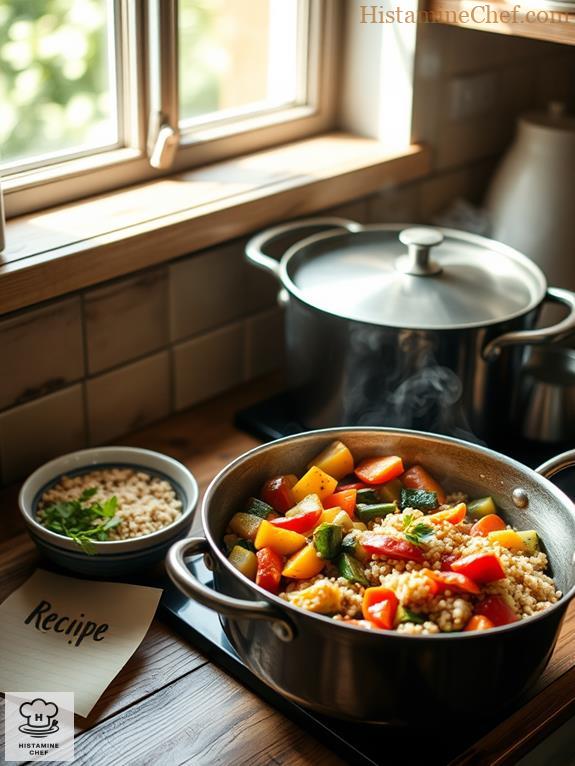
Creating low-histamine meals can be both enjoyable and satisfying. Having the right cooking tools for low histamine meals is essential for successful preparation. Proper equipment can help minimize histamine formation during cooking and guarantee safer, healthier meals.
I love whipping up easy recipes that bring out the best in simple steaming techniques. Picture vibrant vegetables like carrots and zucchini, paired with tender meats like chicken, all seasoned with flavorful herbs like basil and thyme.
These wholesome meals not only taste great but also keep my histamine levels in check. I often cook nutritious grains like quinoa or rice on the side, and don't forget about fresh fruits for dessert! A sweet mango or a juicy peach can really elevate a meal.
So, what're you waiting for? Let's get steaming and create delicious dishes that are good for our bodies and our taste buds!
Welcome to my journey on low-histamine cooking—let's explore together!
FAQ
Can I Steam Vegetables That Are Typically Restricted?
I often wonder if I can steam restricted vegetables. Exploring steaming benefits, I find it enhances flavors while preserving nutrients. Experimenting with various vegetable varieties might lead to innovative, tasty dishes that cater to my needs.
What Kitchen Tools Are Best for Steaming Low-Histamine Foods?
Isn't it ironic? We think fancy gadgets are key, yet simple steaming baskets or electric steamers shine for food preparation. Their steaming benefits preserve nutrients while keeping things low-histamine. Innovation often lies in simplicity, don't you agree?
How Do I Store Steamed Foods to Minimize Histamine?
To minimize histamine levels, I store steamed foods in airtight containers, keeping them in the refrigerator. This innovative approach helps maintain freshness and safety, ensuring I enjoy my meals without worrying about histamine spikes.
Is Reheating Steamed Food Safe for Low-Histamine Diets?
Reheating steamed food's like warming a delicate flower; it can thrive or wither. I've found gentle reheating methods preserve freshness while keeping histamine levels low, ensuring my meals remain vibrant and enjoyable without compromise.
How Can I Enhance Flavor Without Using Restricted Spices?
I love enhancing flavor with herb infusions and citrus zest! They add vibrant notes to dishes without the restricted spices. Experimenting with these can truly transform your meals while keeping them fresh and exciting.
Summary
I've discovered steaming as a valuable technique for low-histamine cooking. It preserves nutrients while creating flavorful meals that don't trigger my symptoms. I'm excited to experiment with different ingredients and seasonings, enhancing my culinary repertoire while prioritizing my health.
What's your experience with steaming for low-histamine diets? Have you found any particular ingredients or methods that work well?
If you found this information helpful, please share it on social media. Your support helps Histamine Chef reach more people managing histamine intolerance through diet.


Leave a Reply